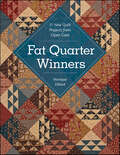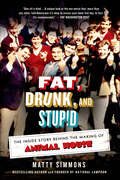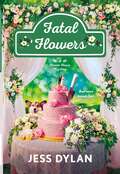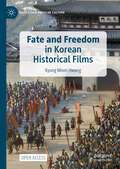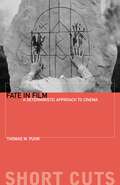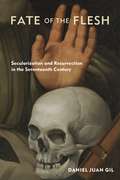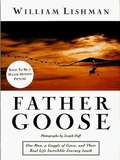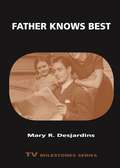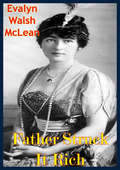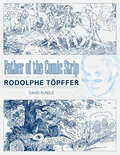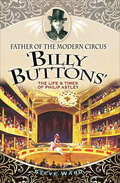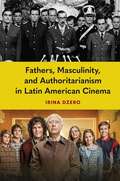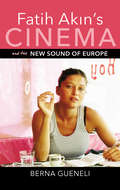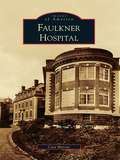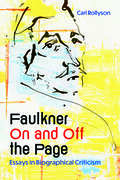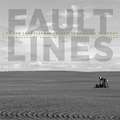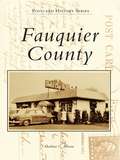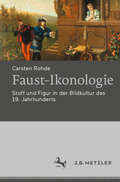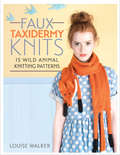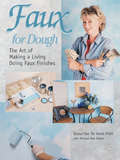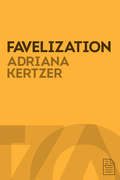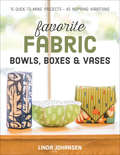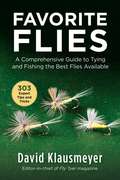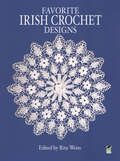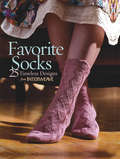- Table View
- List View
Fat Quarter Winners: 11 New Quilt Projects from Open Gate
by Monique DillardWaste no fabric • Put every inch of your favorite fat quarters to work with clever shortcuts and streamlined techniques • Put a pair of light fabrics with a pair of dark fabrics and you're ready to go! • Multiple quilt sizes are included for each project, from a lap quilt to a king-sized bed quilt • Eleven patterns for less than $1.50 each! What makes this fat-quarter book different is the emphasis on using every last bit of each piece of fabric. From block to backing to binding, nothing is wasted. Each project includes Monique's "clever shortcuts," as well as streamlined techniques for easy piecing. Each pair of blocks creates interesting secondary patterns when they're combined to reveal a more complex look. You'll get terrific results stitching up these traditional designs into cherished everyday quilts.
Fat, Drunk, and Stupid: The Inside Story Behind the Making of Animal House
by Matty SimmonsIn 1976 the creators of National Lampoon, America's most popular humor magazine, decided to make a movie. It would be set on a college campus in the 1960s, loosely based on the experiences of Lampoon writers Chris Miller and Harold Ramis and Lampoon editor Doug Kenney. They named it Animal House, in honor of Miller's fraternity at Dartmouth, where the members had been nicknamed after animals. Miller, Ramis, and Kenney wrote a film treatment that was rejected and ridiculed by Hollywood studios—until at last Universal Pictures agreed to produce the film, with a budget of $3 million.A cast was assembled, made up almost completely of unknowns. Stephen Furst, who played Flounder, had been delivering pizzas. Kevin Bacon was a waiter in Manhattan when he was hired to play Chip. Chevy Chase was considered for the role of Otter, but it wound up going to the lesser-known Tim Matheson. John Belushi, for his unforgettable role as Bluto, made $40,000 (the movie's highest-paid actor). For four weeks in the fall of 1977, the actors and crew invaded the college town of Eugene, Oregon, forming their own sort of fraternity in the process. The hilarious, unforgettable movie they made wound up earning more than $600 million and became one of America's most beloved comedy classics. It launched countless careers and paved the way for today's comedies from directors such as Judd Apatow and Todd Phillips.Bestselling author Matty Simmons was the founder of National Lampoon and the producer of Animal House. In Fat, Drunk, and Stupid, he draws from exclusive interviews with actors including Karen Allen, Kevin Bacon, Peter Riegert, and Mark Metcalf, director John Landis, fellow producer Ivan Reitman, and other key players—as well as behind-the-scenes photos—to tell the movie's outrageous story, from its birth in the New York offices of the National Lampoon to writing a script, assembling the perfect cast, the wild weeks of filming, and, ultimately, to the film's release and megasuccess. This is a hilarious romp through one of the biggest grossing, most memorable, most frequently quoted, and most celebrated comedies of all time.
Fatal Flowers: A Flower House Mystery (Flower House series #3)
by Jess DylanFatal Flowers is the third in a colorful cozy mystery series from Jess Dylan, set in the Flower House—where you’re as likely to find a killer as a chrysanthemum. As Aerieville, Tennessee’s Flower House finally gains in popularity, Sierra Ravenswood finds herself feeling ready for new challenges. Luckily, the shop has grabbed the attention of the mayor’s daughter, and bride-to-be, Marissa Lakely. Sierra is thrilled, and nervous, to land her most important job yet: providing flowers for the biggest wedding Aerieville has ever seen.Fortunately, Marissa bucks all stereotypes and is far from a bridezilla—but her wedding planner, Taz Banyan, has apparently taken on the role for himself. He’s uptight, intense, and a little intimidating. But Taz aside, everything seems to be under control...until Sierra makes a startling discovery in the great room: the wedding planner, lying in a heap at the bottom of the stairs, in very bad shape. In fact, he survives only long enough to mutter: "It was the snake." As Granny Mae would say, seeing a snake is rarely a good sign, and this was clearly no exception.With the town on edge and the wedding up in the air, Sierra refuses to stop asking questions in her determination to put an end to this latest danger—so both Aerieville and the Flower House can flourish once more.
Fate and Freedom in Korean Historical Films (East Asian Popular Culture)
by Kyung Moon HwangThis open access book examines the depiction of Korean history in recent South Korean historical films. Released over the Hallyu (“Korean Wave”) period starting in the mid-1990s, these films have reflected, shaped, and extended the thriving public discourse over national history. In these works, the balance between fate and freedom—the negotiation between societal constraints and individual will, as well as cyclical and linear history—functions as a central theme, subtext, or plot device for illuminating a rich variety of historical events, figures, and issues. In sum, these highly accomplished films set in Korea’s past address universal concerns about the relationship between structure and agency, whether in collective identity or in individual lives. Written in an engaging and accessible style by an established historian, Fate and Freedom in Korean Historical Films offers a distinctive perspective on understanding and appreciating Korean history and culture.
Fate in Film: A Deterministic Approach to Cinema (Short Cuts)
by Thomas M. PuhrThe course of events is predetermined and cannot be changed. Forces beyond our control—or even our comprehension—shape our fates. Such is the deterministic worldview embedded in a wide swath of contemporary cinema, from arthouse experiments to popular genre films, through both thematic concerns and narrative structures. These films, especially the recent spate of “elevated” science fiction and horror, tap into this deep-seated anxiety by focusing on characters who ultimately fail to transcend the patterns and structures that define them.Thomas M. Puhr identifies and analyzes the ways that cinema has dealt with the tension between fate and free will, from Stanley Kubrick’s The Shining to Christopher Nolan’s Tenet. He examines films that express deterministic ideas, including circular narratives of stasis or confinement and fatalistic portraits of external forces dictating characters’ lives. Puhr considers determinism at the levels of the individual, the family, and society, reading films in which characters are trapped by past or alternate selves, the burdens of family histories, or oppressive social structures. He explores how films such as Joel and Ethan Coen’s Inside Llewyn Davis, Ari Aster’s Hereditary, Jordan Peele’s Us, and Lucrecia Martel’s Zama confront the limits of human agency. Puhr relates deterministic themes to the nature of moviegoing: In denying characters any ability to choose alternative paths, these films mirror how viewers themselves can only sit and watch.Recasting the works of some of today’s most compelling directors, Fate in Film is an innovative critical account of an unrecognized yet crucial aspect of contemporary cinema.
Fate of the Flesh: Secularization and Resurrection in the Seventeenth Century
by Daniel Juan GilIn the seventeenth century the ancient hope for the physical resurrection of the body and its flesh began an unexpected second life as critical theory, challenging the notion of an autonomous self and driving early modern avant-garde poetry. As an emerging empirical scientific world view and a rising Cartesian dualist ontology transformed the ancient hope for the resurrection of the flesh into the fantasy of a soul or mind living on separately from any body, literature complicated the terms of the debate. Such poets as Donne, Herbert, Vaughan, and Jonson picked up the discarded idea of the resurrection of the flesh and bent it from an apocalyptic future into the here and now to imagine the self already infused with the strange, vibrant materiality of the resurrection body.Fate of the Flesh explores what happens when seventeenth-century poets posit a resurrection body within the historical person. These poets see the resurrection body as the precondition for the social person’s identities and forms of agency and yet as deeply other to all such identities and agencies, an alien within the self that both enables and undercuts life as a social person. This perspective leads seventeenth-century poets to a compelling awareness of the unsettling materiality within the heart of the self and allows them to re-imagine agency, selfhood, and the natural world in its light. By developing a poetics that seeks a deranging materiality within the self, these poets anticipate twentieth-century “avant-garde” poetics. They frame their poems neither as simple representation nor as beautiful objects but as a form of social praxis that creates new communities of readers and writers assembled around a new experience of self-as-body mediated by poetry.
Father Goose: One Man, a Gaggle of Geese and Their Real Life Incredible Journey South
by William Lishman Joseph DuffFeatured on an enormously popular 20/20 segment, this heartwarming story tells of William Lishman, a reclusive sculptor, who adopted a gaggle of geese, flew with them in an ultralight glider, and actually taught them to migrate--earning himself the nickname "Father Goose. "
Father Knows Best (TV Milestones Series)
by Mary R. DesjardinsAlthough the iconic television series Father Knows Best (CBS 1954-55; NBC 1955-58; CBS 1958-60) has enjoyed a long history in rerun syndication and an enduring fan base, it is often remembered as cultural shorthand for 1950s-era conformism and authoritarianism. In this study of Father Knows Best, author Mary R. Desjardins examines the program, its popularity, and its critical position within historical, industrial, and generic contexts to challenge oversimplified assumptions about the show's use of comedy and melodrama in exploring the place of family in mid-twentieth-century American society. Desjardins begins by looking at Father Knows Best within media and production contexts, including its origin on radio, its place in the history of Screen Gems telefilm production, and its roots in the backgrounds and creative philosophies of co-producer Eugene Rodney and star-producer Robert Young. She goes on to examine the social contexts for the creation and reception of the series, especially in the era's emphasis on family togetherness, shared parenting by both father and mother, and generational stages of the life cycle. Against this background, Desjardins also discusses several Father Knows Best episodes in-depth to consider their treatment of conflicts over appropriate gender roles for women. She concludes by exploring how the series' cast participated in reevaluations of the Anderson family's meaning in relation to "real families" of the fifties, through television specials, talk show appearances, magazine and book interviews, and documentaries. Blending melodrama and comedy, naturalistic acting, and stylized cinematic visuals, Father Knows Best dramatized ideological tensions in the most typical situations facing the American family. Scholars of mid-century American popular culture and film history as well as fans of the show will appreciate Desjardin's measured analysis.
Father Struck It Rich (Leisure Class In America Ser.)
by Evalyn Walsh Mclean Boyden SparkesThomas Walsh discovered fabulous golden wealth in the historic Camp Bird Mine near Ouray, Colorado. His daughter, Evalyn Walsh McLean, tells an engaging true story of the family that wanted for nothing. They led a life of extravagance. It enabled them to acquire possessions such as the Hope Diamond and the fabulous homes that hosted spectacular social functions and served as retreats for kings and presidents.-Print ed.
Father of the Comic Strip: Rodolphe Töpffer (Great Comics Artists Series)
by David KunzleSixty years before the comics entered the American newspaper press, Rodolphe Töpffer of Geneva (1799–1846), schoolmaster, university professor, polemical journalist, art critic, landscape draftsman, and writer of fiction, travel tales, and social criticism, invented a new art form: the comic strip, or “picture story,” that is now the graphic novel. At first he resisted publishing what he called his “little follies.” When he did, they became instantly popular, plagiarized, and imitated throughout Europe and the United States. Töpffer developed a graphic style suited to his poor eyesight: the doodle, which he systematized and also theorized. The drawings, with their “modernist” spontaneous, flickering, broken lines, forming figures in mad hyperactivity, run above deft, ironic captions and propel narratives of surreal absurdity. The artist's maniacal protagonists mix social satire with myth. By the mid-nineteenth century, Messrs. Jabot, Festus, Cryptogame, and other members of the crazy family, comprising eight picture stories in all, were instant folk heroes. In a biographical framework, Kunzle situates the comic strips in the Genevan and European culture of the time as well as in relation to Töpffer's other work, notably his hilarious travel tales, and recounts their curious genesis (with an initial imprimatur from Goethe, no less) and their controversial success. Kunzle's study, the first in English on the writer-artist, accompanies Rodolphe Töpffer: The Complete Comic Strips, a facsimile edition of the strips themselves, with the first-ever translation of these into English.
Father of the Modern Circus 'Billy Buttons': The Life & Times of Philip Astley
by Steve WardThe world of the circus has a long and colorful history but it was with a man named Philip Astley that the modern circus was founded. It was 250 years ago, in April 1768, that Astley pegged out a circular ride on the banks of the river Thames and gave performances of trick riding to a paying audience. Trick riding was nothing new, so what made Astley so popular? He was an accomplished horseman, a military hero and an instinctive showman. Above all, he was an entrepreneur who realized that people would pay good money to be entertained and to be entertained well. He created the comic character of Billy Buttons, and other acts were added to his performances: clowns, rope dancers, tumblers and strongmen. The circus, as we might recognize it today, was born.Father of the Modern Circus Billy Buttons investigates the life and times of this veritable giant of the circus world. Standing well over 6 feet tall, with a stentorian voice and character to match, it was difficult to ignore him wherever he went. From his early days as an apprentice cabinetmaker and his military exploits in the 15th Dragoons to the trials and tribulations of establishing himself as a respected performer and his international successes in France and Ireland, this book gives a detailed account of the larger than life figure that was Philip Astley.
Fathers, Masculinity, and Authoritarianism in Latin American Cinema
by Irina DzeroThrough an analysis of twenty-first-century films created in Latin America, this book makes the case that contemporary filmmakers are using the figure of the father as a metaphor for political leadership and that their work reflects a growing rejection of predatory and coercive authority in the region.
Fatih Akin's Cinema and the New Sound of Europe (New Directions in National Cinemas)
by Berna GueneliIn Fatih Akın’s Cinema and the New Sound of Europe, Berna Gueneli explores the transnational works of acclaimed Turkish-German filmmaker and auteur Fatih Akın. The first minority director in Germany to receive numerous national and international awards, Akın makes films that are informed by Europe’s past, provide cinematic imaginations about its present and future, and engage with public discourses on minorities and migration in Europe through his treatment and representation of a diverse, multiethnic, and multilingual European citizenry. Through detailed analyses of some of Akın’s key works—In July, Head-On, and The Edge of Heaven, among others—Gueneli identifies Akın’s unique stylistic use of multivalent sonic and visual components and multinational characters. She argues that the soundscapes of Akın’s films—including music and multiple languages, dialects, and accents—create an “aesthetic of heterogeneity” that envisions an expanded and integrated Europe and highlights the political nature of Akın’s decisions regarding casting, settings, and audio. At a time when belonging and identity in Europe is complicated by questions of race, ethnicity, religion, and citizenship, Gueneli demonstrates how Akın’s aesthetics intersect with politics to reshape notions of Europe, European cinema, and cinematic history.
Faulkner Hospital
by Cara MarcusThe story of Faulkner Hospital begins with the Faulkner family. Dr. George Faulkner's ancestry includes one of the first woolens manufacturers, a Revolutionary War colonel, and an accused Salem witch. When Dr. Faulkner's daughter Mary died, the hospital was established in her honor. Paul Revere's great-granddaughter broke ground on the hospital, which sits on land where the Peacock Tavern, owned by Samuel Adams, once stood. The original building contained 26 beds, 6 of which were free. A nursing school opened in 1903, on the day the hospital opened. Using images from the hospital's vast archives, Faulkner Hospital celebrates the hospital's centennial and explores its rich history as a leader in medicine, education, and community enrichment. Faulkner Hospital is a major teaching hospital to Harvard and Tufts Medical Schools, with many clinical firsts, like the discovery of rejuvenated blood. It is also home to world-renowned breast and headache centers and has implemented many unique concepts, including nurservers and monorails. Readers will learn about the hospital's role in the movie Whose Life Is It Anyway? and discover the famous writers, athletes, and royalty who have visited.
Faulkner On and Off the Page: Essays in Biographical Criticism
by Carl RollysonThough numerous biographies have been published on William Faulkner, readers are often presented conflicting interpretations of his life and work. Faulkner’s view of himself and his own family was mercurial, and it is widely acknowledged that Faulkner was an unreliable narrator of his own life. As a result, biographies of Faulkner echo and complicate the multitude of ways he portrayed himself, accepting that truth—if it exists—is subjective. Like his work, Faulkner’s own life, then, is not only open to different readings but welcomes them within the landscape of his oeuvre.Faulkner On and Off the Page acknowledges the challenges of “factifying” a life into a textual narrative, while also emphasizing the potential for biography to establish a throughline that traces how literature emerges from life and, in turn, shapes the life narrative Faulkner constructed for himself. Unburdened by the sanctity of the written word, Faulkner embraced mutability and perpetual evolution. This process of reinvention also manifests within the pages of Faulkner's biographies, as each biographer brings a unique context and perspective shaped by generations of Faulkner scholars.Rather than thinking of Faulkner as exclusively the great high modernist who strayed to Hollywood when he needed the money and stayed home when he didn’t, this book portrays an unsettled writer incessantly on the move incorporating what only looked like alien elements into his work, while maintaining a public persona that disparaged anything that did not fit the narrative of the novelist he created in interviews, essays, and speeches. This book attempts to carry on the work of finding the man on the page even as he is shaping a life off of it.
Fault Lines: Life and Landscape in Saskatchewan's Oil Economy
by Emily Eaton Valerie ZinkOil is not new to Saskatchewan. Many of the wells found on farmland across the province date back to the 1950s when the industry began to spread. But there is little doubt that the recent boom (2006–2014) and subsequent downturn in unconventional oil production has reshaped rural lives and landscapes. While many small towns were suffering from depopulation and decline, others reoriented themselves around a booming oil industry. In place of the abandoned houses and shuttered shops found in many small towns in Saskatchewan, housing developments sprang up with new trucks and boats parked in driveways. Yet people in oil-producing areas also lived amid flare stacks that made them ill, had trouble finding housing due to vacancy rates that were among the lowest in the country, suffered through family breakdown because of long working hours and time spent away from home, and endured spills and leaks that contaminated their land. In the summer of 2014, at the height of the boom, geographer Emily Eaton and photographer Valerie Zink travelled to oil towns across the province, from the sea-can motel built from shipping containers on the outskirts of Estevan to seismic testing sites on Thunderchild First Nation’s Sundance grounds.
Fauquier County (Postcard History)
by Matthew C. BensonFauquier County, officially established in 1759, was named after Francis Fauquier and has long been known for its Civil War history, large farms, country estates, small towns including Warrenton and Marshall, and quaint villages including Upperville, Delaplane, and The Plains. Today its rural historic beauty and preserved open spaces lure Washingtonians away for day-trips and weekend retreats. Well-known industry baron Walter Chrysler, philanthropist Paul Mellon, and movie and television stars Robert Duvall and Willard Scott have all called Fauquier home.
Faust-Ikonologie: Stoff und Figur in der Bildkultur des 19. Jahrhunderts
by Carsten RohdeDie Geschichte des Faust-Stoffes seit Goethe ist lange Zeit vor allem unter ideologischen Gesichtspunkten gedeutet worden. Die vorliegende Studie untersucht erstmals tiefergehend die populärkulturellen Resonanzen von Faust in der sich formierenden Medienmoderne des 19. Jahrhunderts. Die ‚Explosion der Bilder‘ sorgt dafür, dass Stoff und Figur in einer nie dagewesenen Vielfalt und Breite als visuelles Phänomen in Erscheinung treten. Faust wird zu einer populären Projektions- und Identifikationsfigur, die mit ganz unterschiedlichen Formen, Funktionen und Kontexten in Verbindung steht. Ihre Omnipräsenz in der Bildkultur des Jahrhunderts ist sowohl Spiegel als auch Katalysator dieser Entwicklungen.
Faux Taxidermy Knits: 15 Wild Animal Knitting Patterns
by Louise WalkerFaux Taxidermy Knits offers you 15 fabulously quirky and fun knitting patterns that tap into the massive trend for taxidermy inspired craft projects with an ironic twist! Split into two sections, wearables and habitat, this unique book includes knitting patterns from moose and badger wall hangings and tiger rugs, to fox stoles and claw mittens for the modern, young knitter looking for something very different and new to create. The style of the book is very contemporary and fun with modern-retro photography to compliment the quirky nature of the projects. Lousie Walker is a young up and coming UK designer, professional knitter and blogger at www.sincerelylouise.blogspot.co.uk.
Faux for Dough: The Art of Making a Living Doing Faux Finishes
by Teresa Van De Veere PrattHome-based business popularity is at an all-time high. Skilled decorative painters considering going into business now have an instruction guide to ease the transition. Teresa Van De Veere Pratt, an expert in the field of faux finishing, shares her generous knowledge of the business in this detailed book. From faux finishing techniques to necessary tools, and from sample contracts to how to attract customers, this reference walks readers through the essential steps needed to start and keep running their own faux finishing business.
Favelization
by Adriana KertzerIn Favelization, Kertzer sets out to understand the ways in which specific producers of contemporary Brazilian culture capitalized on misappropriations of the favela (informal squatter settlements that grow along the hillsides and lowlands of many Brazilian cities) in order to brand luxury items as "Brazilian." Kertzer analyzes the the works of artists and designers citing instances of engagement with primitivism and stereotype to make their goods more desirable to a non-Brazilian audience. The author further argues that the processes of interpretation, aestheticization, transcendence, and domination are part of the favelization phenomenon. Originally written by Kertzer as a thesis for Parsons The New School for Design's Masters program in the History of Decorative Arts and Design, Favelization locates design as part of a broader constellation of representations that includes a variety of forms from printed media to film.
Favorite Fabric Bowls, Boxes & Vases
by Linda JohansenThe author of Fast Fun & Easy Fabric Bowls shares how to make beautiful containers out of fabric with these 15 easy projects.Organize every room in your home with decorative fabric bowls, boxes, and vases! With 15 projects you can easily make in a day, best-selling author Linda Johansen teaches you to sew sturdy fabric containers of all shapes and sizes to corral your odds and ends. Each pattern includes stylish variations and embellishments ranging from artistic to playful. Ideal for gift giving and displaying treasured fabrics, these handpicked projects are perfect to make, use, and share. We bet you can’t stop at just one!• 15 addictive projects, plus variations and embellishments to make them your own• Organize every room in the house! Containers of all shapes and sizes to get you sewing• Time-tested patterns from bestselling author Linda Johansen
Favorite Flies: A Comprehensive Guide to Tying and Fishing the Best Flies Available (Fly Tyer Ser.)
by David KlausmeyerFavorite Flies is the latest fly-tying manual from acclaimed writer and fisherman David Klausmeyer, in which his 303 best flies have been brought together for the ease of fly fishers everywhere. Whether you are a beginner seeking a comprehensive tying guide or an experienced tier yearning for detailed information on the most successful flies, this book has it all. Each fly featured comes with a complete recipe, step-by-step tying instructions, and specialized fishing tactics. Included within this tier-friendly manual are detailed text blocks that carefully describe each tying step for each featured fly. Supported with a materials recipe for each fly, the many images of the tools, materials, and flies make it easy to understand and tie even the most complex flies. With this guidebook, you&’ll learn to master the classic patterns, as well as hot, new innovative ones. Fly tying is not only a craft, but an art form. In Favorite Flies, Klausmeyer will help you excel at both. Avid sport flyfishermen will treasure this book and gain even more in-depth knowledge.
Favorite Irish Crochet Designs
by Rita WeissCreate airy and delicate lace designs for table, bed, and wardrobe using the time-honored technique of Irish crochet. This handsome handicraft, known for its raised floral motifs and intricate background patterns, probably originated in the convents of Ireland, where diligent nuns prepared beautiful ornaments for use in church services. Today, this stunning form of lace-making has been adapted and simplified for dozens of day-to-day uses: decorating curtains, tablecloths, pillows, bedspreads, lingerie, collars, children's clothing, doilies, and more.Rita Weiss, a noted needlework designer and bestselling author, has collected the finest, easily workable examples of Irish crochet from rare American thread company booklets of more than 50 years ago. Step-by-step instructions, stitch and hook charts, metric conversion charts, and 40 clear illustrations allow you to make magnificent accessories in these lovely patterns: My Wild Irish Rose, Popcorn, Rose of Sharon, Cinderella, More Than a Touch of Blarney, Beauty Rose, "Smilin' Through," Tournament of Roses, Wedding Ring, Dublin Beauty, Irish Springtime, and others. No skills beyond a familiarity with ordinary crochet technique are needed to create these beautiful patterns. In addition, expert tips on blocking and finishing make it certain that your final product will be nothing short of a work of art.With this versatile, inexpensive guide, the beauty of Irish crochet -- once thought too difficult to achieve by any but the most experienced needleworkers -- is now within reach of even beginning crocheters.
Favorite Socks: 25 Timeless Designs
by Ann BuddPortable, quick to knit, and universally wearable, new knitters have recently been discovering socks in droves, while Interweave Knits magazine has been providing original, beautiful patterns for a decade. Featuring 25 beautiful and timeless sock patterns for every occasion in a range of techniques, traditions, and designs, many of these patterns have become unavailable as original issues of Interweave Knits went out of print, but are available once again in this inspired collection. Highlights include a tutorial for knitting socks on two circular needles, instructions for making resoleable socks, and six completely new designs for those avid knitters who may have every issue of Interweave Knits magazine.
